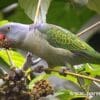DID YOU KNOW?
The Blue-rumped Parrot’s calls carry very long distances.

Psittinus

cyanurus
Size:
18 cm (7 in)
Weight:
85 g (3.0 oz)
Subspecies including nominate:
three: P.c. cyanurus, P.c. pontius
Colour Adult:
P.c. cyanurus: Male-blue head; pale brown underparts; black mantle and upper back; blue lower back to upper tail coverts; red bend of wing, flanks and underwing coverts. Upper mandible red, lower mandible brown. Eye yellow. Female-brown head; green upperparts, with lower back blue; green underparts. Beak brown. Eye white.
P.c. pontius: Both adults larger than cyanurus.
Colour Juvenile:
P.c. cyanurus: As in adult female, but with green head.
P.c. pontius: As in adults.
Call:
Calls are distinctive; in flight a sharp, whistling, two-or-three-note series of sounds. Also gives high-pitched peeps and song-like trilling.
More Information:
Content Sources:
CITES
BirdLife International
Cornell Lab of Ornithology/Birds of the World
Parrots: A Guide to Parrots of the World, Juniper and Parr, 1998
Parrots of the World, Forshaw and Cooper, 1977. 2010 edition
Parrots of the World, Forshaw, 2006.
Parrots in Aviculture, Low, 1992.
Lexicon of Parrots, Thomas Arndt.
Captive Status:
Rare
Longevity:
—
Housing:
Walk-in enclosure, minimum length 2.1 m (7 ft) or indoor cage minimum length 1.8 m (6 ft).
Diet:
Small seed mix such as: canary, oats, safflower, and a little hemp; spray millet; limited sunflower seed, dry, soaked or sprouted; sprouted beans and pulses such as mung beans, cooked butterbeans and lentils; boiled maize; green leaves such as: Swiss chard, lettuce, sowthistle, dandelion, chickweed; vegetables such as: carrot, celery, green beans and peas in the pod; fruit such as: apple, pear, orange, banana, cactus fruits, pomegranate; nuts such as: lightly cracked hazelnuts, pecans, pinenuts and roasted peanuts; complete kibble.
Enrichment:
Hard chewer, so provide bird-safe, unsprayed branches of fir, willow, pine and flowering trees; wooden block toys, heat sterilized pine cones and vegetable tanned leather toys. Also enjoys bathing so provide overhead misters or shallow bowls of water.
Nest Box Size:
Vertical box 6″ x 6″ x 16″ (15.2 cm x 15.2 cm x 40.6 cm)
Clutch Size:
3-5
Fledging Age:
6 weeks
Hatch Weight:
—
Peak Weight:
—
Weaning Weight:
—
World Population:
Unknown but described as common, decreasing.
IUCN Red List Status:
Near Threatened
CITES Listing:
Appendix II
Threat Summary:
Not globally threatened. Extensive forest destruction in the Sundaic lowlands may have affected this species, although it does use fragmented forest at higher elevations. Race abbotti suspected to number fewer than 5000.
Range:
P.c. cyanurus: Tenasserim, southern Burma, and SW Thailand, south through Malay Peninsula to Sumatra, Bangka Island and Borneo.
P.c. pontius: Siberut, Sipora, and North and South Pagai, in Mentawai Islands, Indonesia.
Habitat:
Found up to 700 m (2296 ft) in lowland forests including open woodland, secondary growth, orchards, mangroves, dry forest, swamp forest, cultivated areas including oil palm plantations, dense scrub and coconut groves.
Wild Diet:
Diet includes mesocarp of oil-palm fruits, fruits of Macaranga rhizinoides and seeds of Parkia speciosa; also fruits of Averrhoa carambola.
Ecology and Behaviour:
Not shy, gregarious birds found in groups of up to 20 individuals. Birds forage quietly in the canopy or fly swiftly above the forest, wheeling around the tree tops calling frequently.
Clutch and Egg Size:
3-5 rounded eggs, 24.5 x 20.0 mm (0.95 x 0.8 in)
Breeding Season:
February-May, Malaysia; May-September, Borneo. Nest is in tree hollow.
Related Links:
—
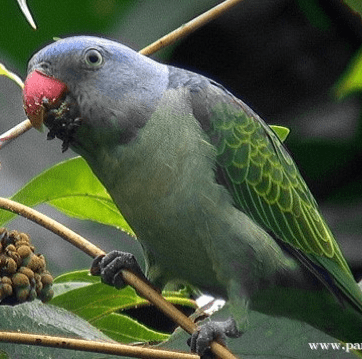
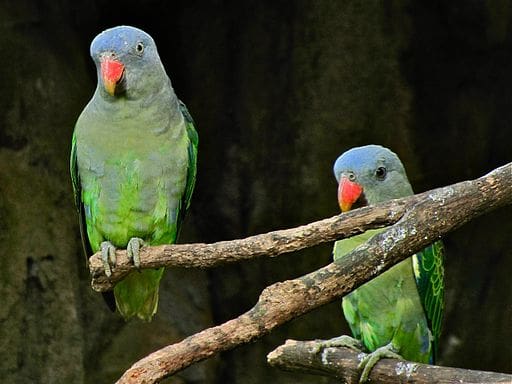
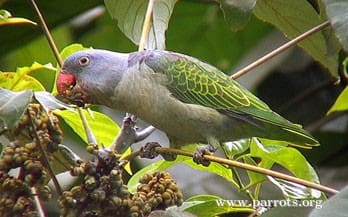
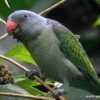
![© Bernard DUPONT [CC BY-SA 2.0] via Wikimedia Commons Simeulue Parrots perch in an aviary](https://gt2024.parrots.org/wp-content/uploads/2023/01/wpt_Blue-rumped-Parrot_1276-2-100x100.jpg)
